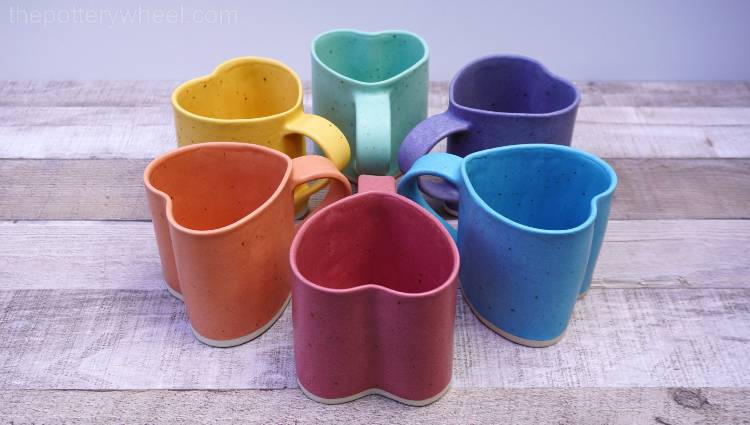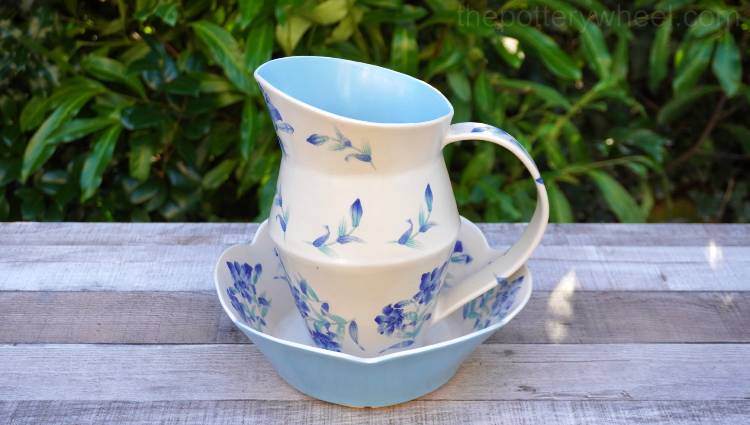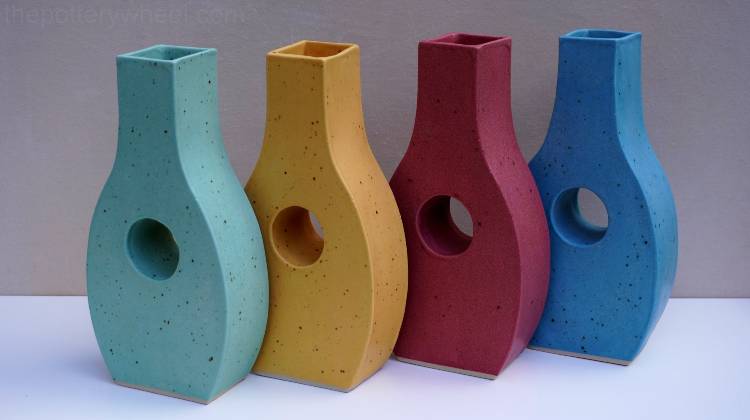Your cart is currently empty!
What is Slip in Pottery? – More Versatile Than You Think!
Published:
Last Updated:
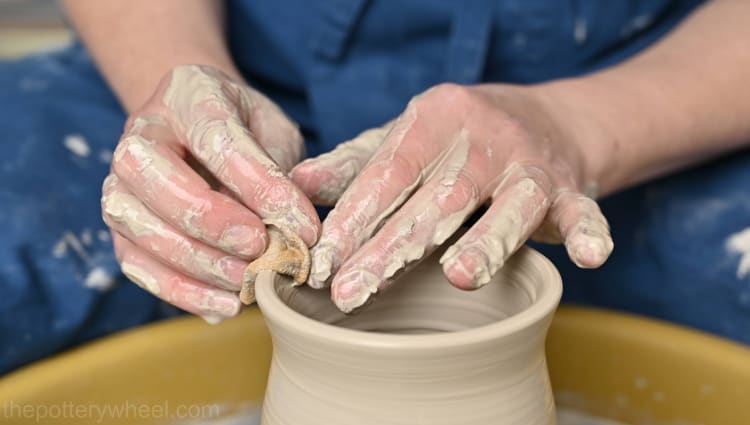
Affiliate Disclaimer
As an affiliate, we may earn a commission from qualifying purchases. We get commissions for purchases made through links on this website from Amazon and other third parties.
Whether you are hand building pottery or using a potter’s wheel, clay slip is an essential part of pottery making. But, exactly what is slip in pottery? Here is what you need to know…
Slip is liquid clay. It is made by mixing clay with water. Sometimes other ingredients such as colored stains are added to make colored slip. Clay slip is used to join pieces of clay together. It is also used for decorating pottery and when pots are made through a process of slip casting.
There are different kinds of clay slip and they have different uses. Let’s take a closer look at what they are and how they are used.
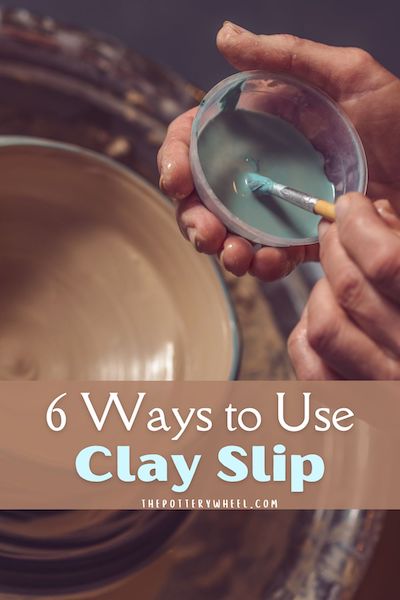
What is Clay Slip in Ceramics?
Pottery clay is made up of clay particles. The more water you add to the clay particles, the softer the clay will become. If you add sufficient water to the clay, the particles become suspended in a liquid. At some point, as you add water, the clay will turn from being a workable but solid substance to a liquid. This liquid is clay slip.
Clay slip, sometimes called ceramic slip, comes in different consistencies. Some clay slip is quite thin and runny. Other clay slip is quite thick and almost gloopy. Thicker slip is often called slurry, though the terms slip and slurry are also taken to mean the same thing.
What is Clay Slip Used for In Pottery?
Clay slip has lots of different uses, and it’s hard to make pottery without also using slip. Here are some of the ways that clay slip is used in ceramics.
- Joining pieces of clay
- On the Potter’s Wheel
- Decorating with clay slip
- Casting clay slip in a mold
- Flashing slips
- Engobe
Here is a closer look at each of these uses…
1) Joining Slip
At some point when you are making pottery, you are going to need to join some pieces of clay together. For example, joining slabs of clay or fixing handles on mugs. Clay slip is usually used as a glue to bond two or more bits of clay together.
If the clay that you are joining is still very fresh, you may get away with simply pressing the two surfaces together. The moisture in the clay will help the clay particles to mingle together.
However, if the clay has started to firm up even a little, then it’s a good idea to use clay slip to bond them.
Clay slip is usually used as a joining agent in the following way. The surface of the two pieces of clay to be joined are scored using a texturizing tool. This could be a special tool like a serrated rib tool, or a clay texturizing tool. Or you could use something as simple as a dinner fork or a needle tool.
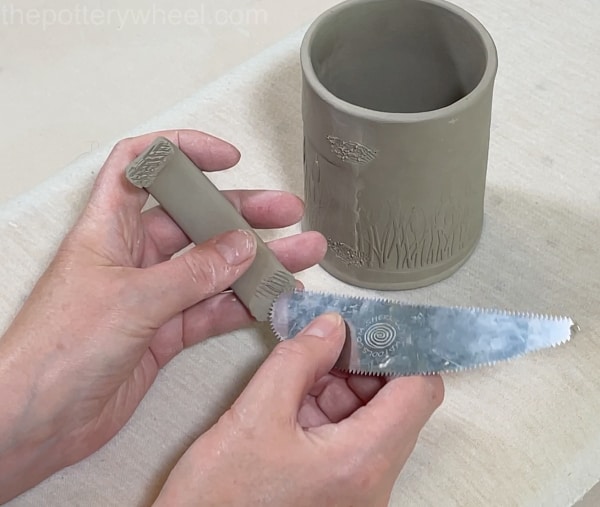
Either way, the clay texture is made rough. Liquid clay in the form of clay slip is then applied to the rough texture, and the two pieces of clay are pressed firmly but gently together.
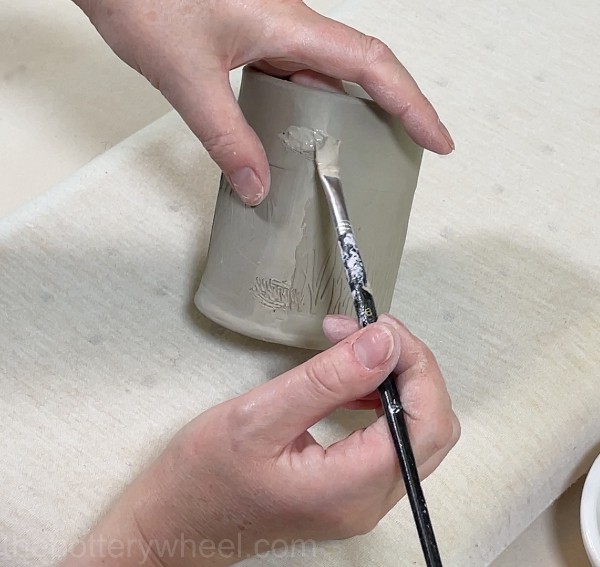
When the two surfaces meet, the liquid clay slip mingles together and the rough surfaces key into one another and create a firm join. This method of joining clay is called slip and score.
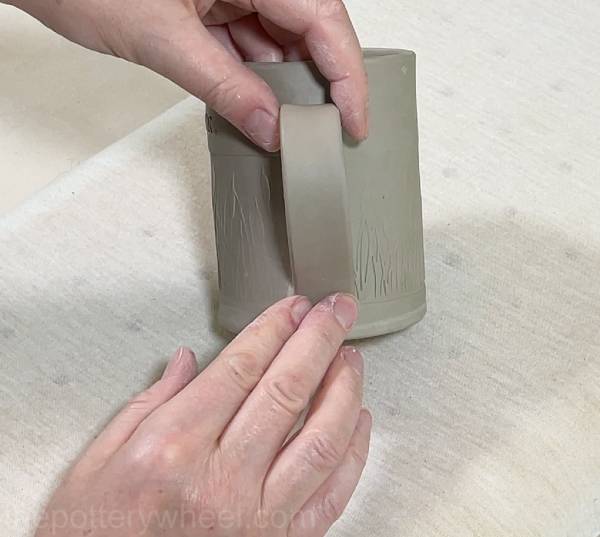
If you don’t use clay slip when joining clay that has started to firm up, chances are the clay will separate or crack at the join as it dries. Joining slip will help the bond survive the drying process.
2) Clay Slip on The Potter’s Wheel
One use of clay slip that is often forgotten about is the role it plays in throwing pots on the wheel. When you are making pottery on the wheel, the clay needs to glide beneath your hands as the wheel turns. This is made possible by adding water to your hands and the clay.
The movement of the clay beneath your fingers mixes the clay particles and the water to make slip. This slip is what makes it possible to shape the clay without it sticking to your hands.
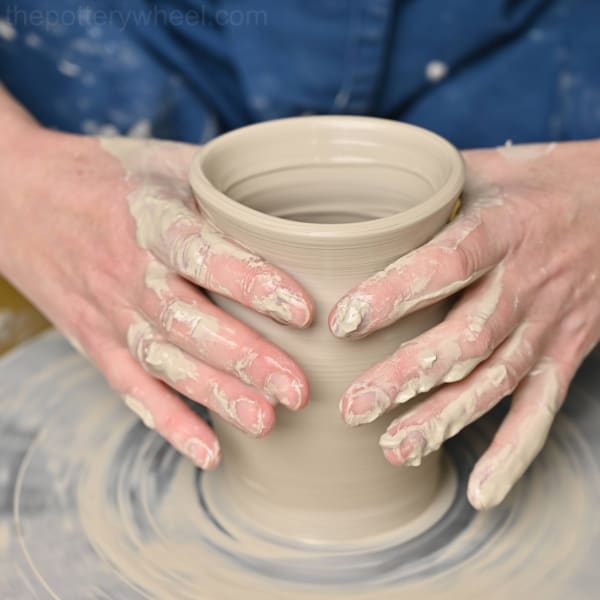
3) Decorating Slip
Slip can also be used for decorating pottery. It can add color and texture to pottery using a range of techniques.
To add color to a pot using slip, you can either buy colored clay decorating slip. Alternatively, it’s easy to make your colored slip. I made a guide on making colored decorating slips, which you can check out here.
The good thing about making your own colored slip is that you can make it exactly the color that you want it to be. Having said that, there is a good range of decorating slips that you can buy too.
It can be applied to pots in the following ways:
Painting
Like underglaze, slip can be painted onto pottery to create designs. The difference between slip and underglaze is that painted slip can also give the decoration a bit of texture. Slip is thicker than underglaze and can create a velvety slightly raised painted finish.
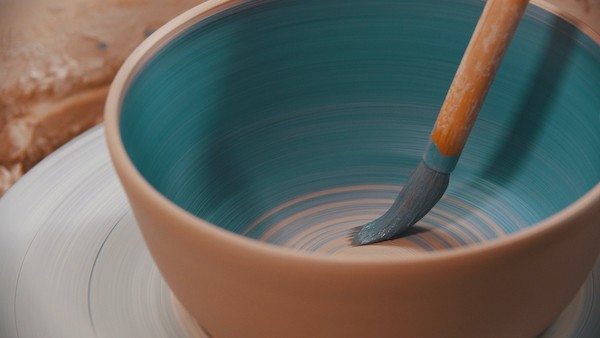
Dipping
Pottery can be dipped into clay slip. Dipping will give the pot an even coat of slip. The benefit of coloring clay with slip is that you can color the underside of your pot without worrying that it will stick to the kiln shelf as it is fired.
Pouring
Clay slip can be poured over pottery too. This is one of my favorite ways to use decorating slip because it can create nice random shapes and layers.
You can pour it over a piece of pottery and create layered colors. Or you can pour a few different colors onto a piece and then move the slip around whilst it’s still wet. This will create a marbled effect.
Slip trailing
Another way of decorating pottery with slip is called slip trailing. In slip trailing the liquid clay is applied to the pot using an applicator called a bulb syringe.
A bulb syringe is usually made of a rubber bulb the size of the palm of your hand. A nozzle is fixed to the rubber bulb. As the bulb is squeezed the clay slip comes out of the nozzle and can be dripped or trailed onto the surface of the pot.
The clay slip used in slip trailing is quite thick because you want the drops of clay to create a bit of texture on the surface of the pot. If the slip is very thick it can leave little sharp ends at the end of a trail.
These sharp ends are a bit like the end of a meringue when it comes out of a piping bag. You can get rid of them by pressing them down once the trail has begun to dry out but is still soft. Or you can add a little more water to the clay slip to thin it down.
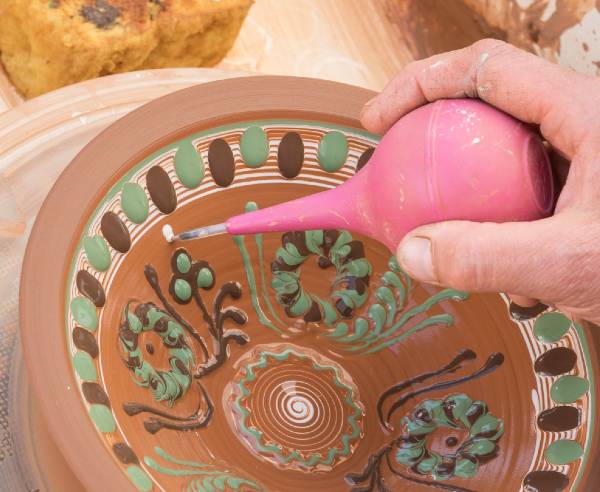
4) Casting Slip
Another use of slip is called ‘slip casting’. In slip casting, a thinnish slip about the thickness of buttermilk is poured into a plaster mold. Water from the clay is absorbed by the plaster mold.
As the water is drawn out of the slip, a solid clay skin forms on the surface of the plaster mold. After about 30 minutes, any clay slip that is still liquid is poured out of the mold again.
The clay skin is left behind in the mold. As this dries out more, it shrinks away from the mold surface. Plaster molds are often made in more than one piece. The mold can be taken apart and the slip cast pottery can be removed.
Once it’s removed from the cast, any seams or edges on the pot can be tidied up. Handles and other details can then be joined onto the cast piece of pottery.
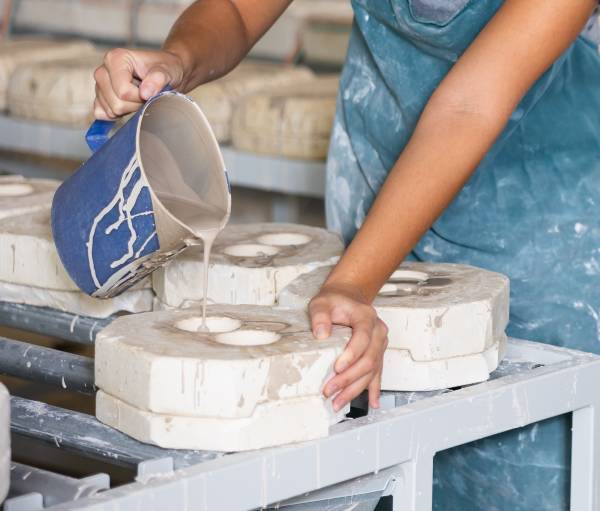
Tips on Using Clay Slip
Special Kinds of Clay Slip
Other kinds of clay slip are used in particular ways. Here are another couple of types of slip that are a bit more unusual.
5) Flashing Slips
Flashing is an effect that is created on the surface of pottery when it is being fired. It is a change in color and sometimes in texture and it has a natural random look. It can be very beautiful and it happens when there is a change in the atmosphere in the kiln.
Electric kilns have quite a stable firing environment. But gas or wood-fired kilns have more unpredictable results. This is because the atmosphere changes and there are often flames or ash present in the kiln as it fires.
Flashing occurs when ash settles on the pot, or it is produced when oxides in the clay or glaze are volatilized. Some potters deliberately cause changes in the atmosphere to create flashing by introducing vapors from soda or salt into the kiln as it fires.
‘Flashing slips’ can also be used to create the flashing effect. For example, slips containing alumina react (or flash) in an atmosphere that creates salt (soda) and ash.
These slips are about the same thickness as milk, and they are painted onto bisque ware. Bisque is pottery that has already been fired once in a kiln. You can read more about bisque pottery here.
6) Engobe
Engobe and slip have some similarities, but strictly speaking, they aren’t the same. Like slip, engobe is a liquid that is used to decorate pottery. It can be used to improve the texture of the pot or to add color.
Colored engobe usually contains stains and metal oxides. It is opaque, which means that it’s not see-through, and it can be white or colored.
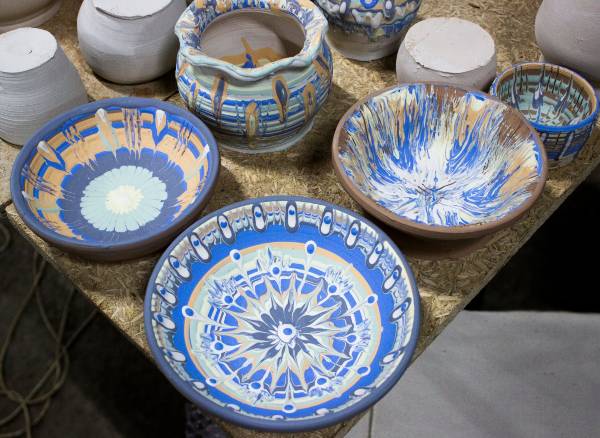
Engobe Vs Slip
One difference between slip and engobe is that engobe contains less clay. It also contains more silica and flux than slip. These are materials that cause the engobe to melt and become glass-like when it’s in the kiln.
Clay has a high water content, and it shrinks a lot when it dries. Because engobe contains less clay, it shrinks less than slip as it dries. As a result, engobe can be used on leather hard clay or bisque-fired clay.
Engobe is sometimes described as being halfway between a slip and a glaze. Fired engobe surfaces have a slight sheen, whereas fired slip surfaces are matte. Sometimes engobe is referred to as an underglaze. Like slip, a clear glaze is usually painted on top of engobe to give it a glossy seal.
Making Clay Slip
Making ceramic slip is very easy. Exactly how you make your slip depends on how you want to use it. Here is how I make joining slip.
Step 1
Allow some of the clay that you are using to dry out and become bone dry. It’s best if these pieces are on the smaller side.
Step 2
When the clay is dry, transfer it into a bowl or container. Add enough water to submerge each of the pieces of dried clay.
Step 3
Let the clay sit overnight. The clay will slake down overnight. Slaking down is a term used to refer to clay as it dissolves in water. Dry clay breaks down in water more quickly and evenly than moist clay.
Step 4
Mix the clay and water thoroughly to make a smooth creamy paste.
Super Strong Joining Slip
Most of the time, slip is made of just two ingredients, clay and water. However, you can adjust the ingredients a little to make a very strong joining slip.
Instead of mixing your dried clay with water, you can dissolve the clay into vinegar. Vinegar is known as a flocculant. Flocculants are substances that cause clay particles to be attracted to one another, and it makes the slip quite sticky.
In addition to this, you can add some paper pulp to the slip. The fibers in the paper pulp will also give the slip some extra strength. This type of slip is called paper clay slip. You can check out my step-by-step guide on how to make paper clay slip here.
What is Slipware?
Pottery that has been decorated by slip is sometimes referred to as ‘slipware.’ This term tends to be restricted to pottery items where the slip has been applied in a pattern either by a brush or another implement as in slip trailing. If the slip has been applied to an entire item, through for example dipping, it does not tend to be referred to as ‘slipware’.
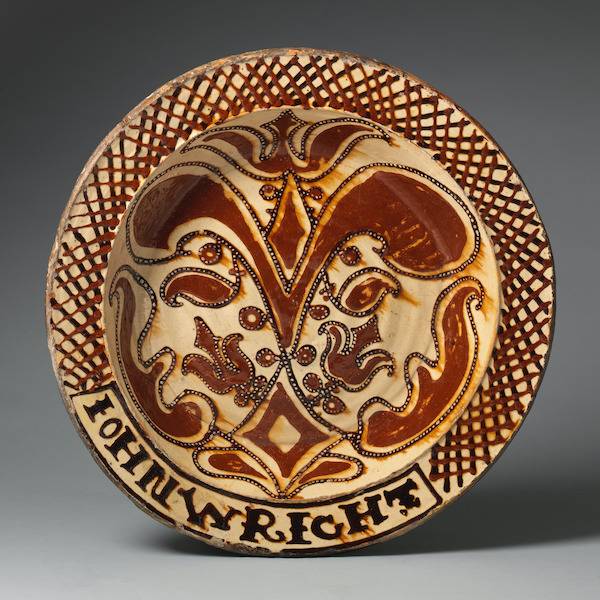
If you’d like to know more about slip ceramics, you can check out my guide to slipware here.
Final Thoughts
Although pottery slip is a simple material, it’s essential for hand building and wheel throwing. Clay slip used for different purposes can have different properties, but basically, it’s liquid clay. If you’d like to know how to make colored clay slip, you can check out this step-by-step guide here.

